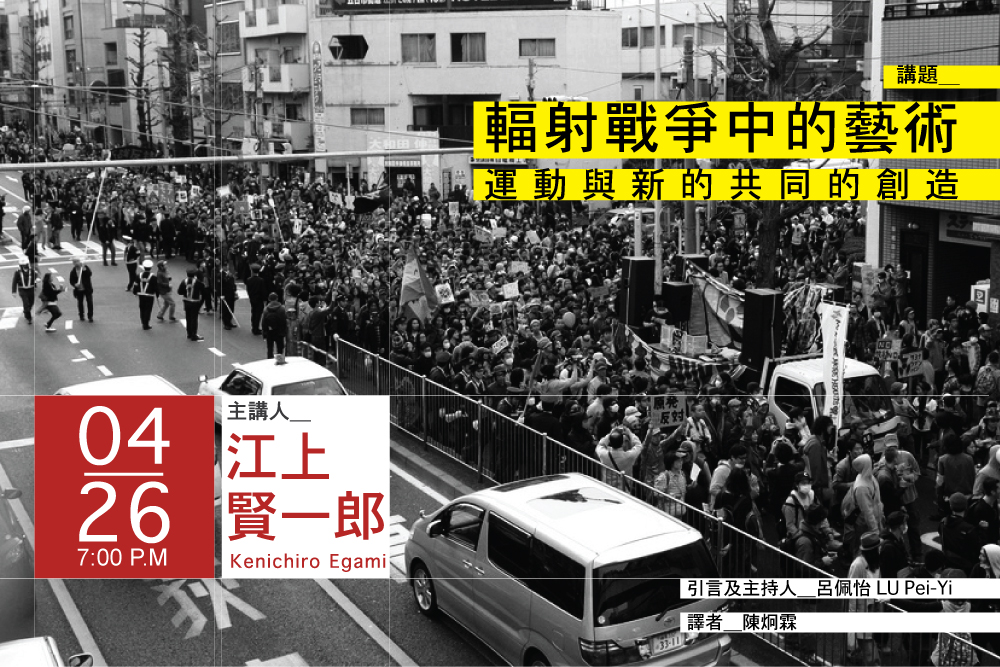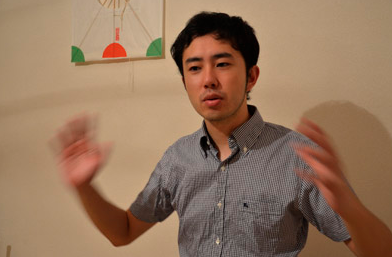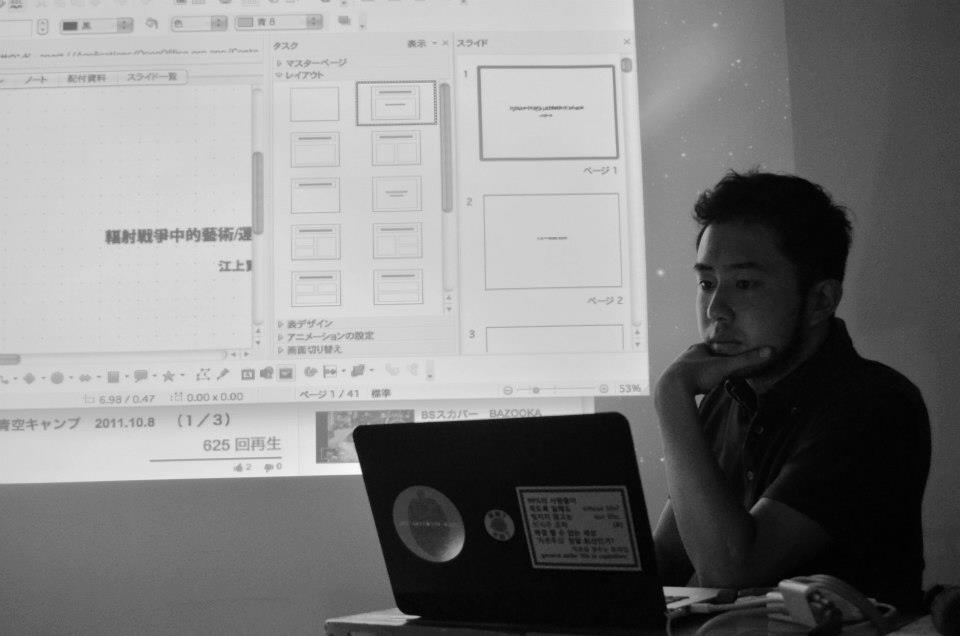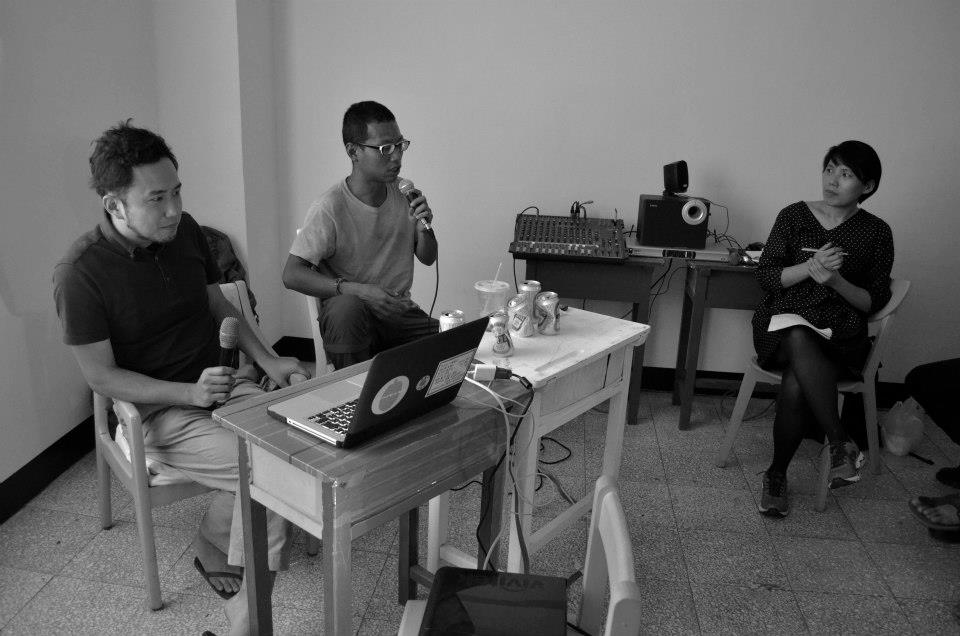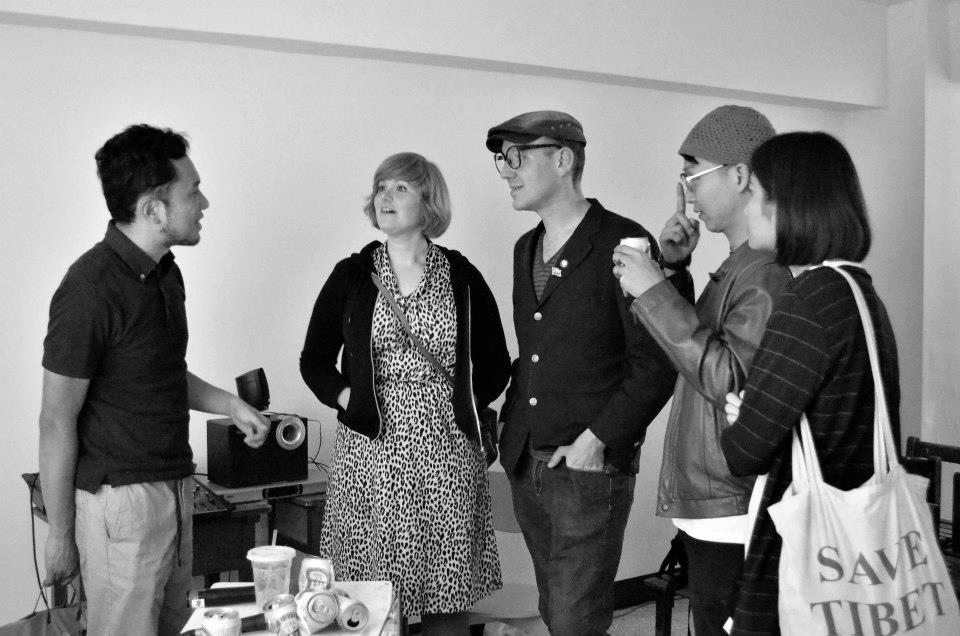輻射戰爭中的藝術──運動與新的共同的創造
主講人:江上賢一郎
引言及主持人:呂佩怡
譯者:陳炯霖
2011年3月大地震及福島第一核電廠爆炸事故以後,
事故不久後,社會開始出現「現在藝術到底能做什麼?」的提問,
311之後,以往從來沒有交流的人們開始自主聚集、學習組織,
藝術/運動提供了人民否定既有社會的想像力,
4/26 Art of the Nuclear War—Collective Creation and Movements
Speaker: Kenichiro Egami
Host: Lu Pei-Yi
Interpreter: Chen Jiong- Lin
After the March 2011 earthquake and Fukushima explosion, the Japanese government ignores the dangers of radioactive pollution and puts a veil over the truth. They reactivated nuclear reactors, stopped compensating victims of the disaster, allowed polluted food to flow freely in the market and transported radioactive rubbles to different locations. And the government continues to brainwash the public through the media. Under these relentless measures and policies, the public seeks to fight radioactive pollution through grass root organizations and movements.
It wasn’t long before the question “What can art do now?” was raised among society. This became an opportunity for people to reflect on the relationship of art and society once more. A group of artists and activists spoke out against the dishonest government through various forms of art and social movements.
These people from different backgrounds and cultures have a common goal: They aspired to make the invisible war visible through art and transform the current state into a message.
After 311, people who otherwise would have never met each other came together. They united to form organizations and continued to support the damaged areas and anti-nuclear movements. Some people have even chosen to become “voluntary refugees” due to radioactive pollution. A new art form that is closely related to everyday life has come into bloom.
Japanese scholars then expanded the renowned theory of Joseph Beuys into “Every one is not only an artist, but also an activist.” Art has the power to open the doors of a new world, while social movements strive to change society of today trough action. The power of art and social movements mingle and merge into what could be a new fusion, Art/Movement.
Art/movement stimulates imagination and awareness of how people are capable of changing the society as we know it. And through productive debate, urge people to take action from another standpoint. Kenichiro Egami, independent researcher, activist and photographer, shares how after the nuclear disaster in Japan people began to form Art/Movement through the new survival technique “Ars + Techne.” He also hopes one day the revolutionary idea of Art/Movement can widely spread its seeds to different corners of the world.
講者簡介:
江上賢一郎
獨立研究者, 攝影行動者
目前生活與工作於日本福岡。在英國求學期間,
Kenichiro Egami
Independent researcher / Photographer
Currently living and working in Fukuoka, Japan. While studying in UK, he began to participate in political and social movements and also documented political actions in Europe and Japan. His is mainly concerned about issues such as Gift Economy, anthropological studies of political movements, anarchism, political photography…etc. In 2010, he began organizing a workshop on art and activism in Fukuoka city. In his recent visit to Taiwan, he is joined by Matsumoto Hajime, who is the leader of “Amateur Riot.” Their main goal is to investigate the nuclear waste in Orchid Island. In May, “Creative Space – Art and Spatial Resistance in East Asia” will be published in Hong Kong, and in this book, he discusses the current state of Japan.
主持人簡介
呂佩怡
獨立研究者,藝評人
研究興趣為策展研究、Off-Site Art(美術館外的藝術實踐)、美術館議題等。
LU Pei-Yi is an independent researcher and art critic. Her research interests are issues of curating, off-site art and museum studies. She edited “Off-Site Art in Taiwan, Hong Kong and China” Special Issue of Yishu: Journal of Chinese Contemporary Art (2010) and the book Creating Spaces- Post Alternative Spaces in Asia (2011). Her book Off-Site Art curating was also published in 20011. In 2012, she was invited to participate a conference and talk in Japan twice so had an opportunity to observe the transformation of contemporary art after 311. She served as a visiting assistant professor of Chinese University of Hong Kong in the autumn term of 2012.
譯者簡介
活動記錄:
文字 text(中文/ ch):簡于庭
文字 text(英文/ en):周思婷 Christine Chou
攝影 photo:張巧怡 Joy Chang
看不見的社會戰爭
本次講座請到具有社會學、人類學與藝術史背景並透過攝影觀點看世界的江上賢一郎來來台分享日本藝術圈與一般大眾在核災後的一些轉變。江上賢一郎以分享福島核電廠爆炸的新聞片段拉開了這次講座序幕。當他第一次看該片段時,認為不僅僅是日本,全世界都要面臨世界末日了,然而世界依舊運轉,僅僅日本因福島核災有了巨大的改變。他提到日本像是在打一場看不見的戰爭,除了對抗飄散在空氣中看不見的輻射,還要面對政府與主流媒體的安全洗腦。也因為政府隱瞞真相的種種案例,江上賢一郎認為日本藝術家當前最重要的工作便是將看不見的輻射轉化成能夠被傳地出去的訊息。
將等級七的世界可視化
以福島核災為創作主題的藝術團體Chim↑Pom為例,他們在核災發生不久後前往涉谷車站,將核災爆炸的圖案畫在車站內岡本太郎以廣島核爆為主題的名畫「明日的神話」上,又或是竹內公太(KOTA TAKEUCHI)以核電工人的身分潛入核電廠,在核電廠內單一角度的攝影機前指著攝影鏡頭。江上賢一郎認為這件作品有著更深一層的意涵,藝術家不僅僅是將核電工人與輻射這些看不見的存在得以被看見,也默默指控著被隱藏住的資訊與冷漠民眾。另外,東京首次以核電廠輻射為主題的展覽–「原子能現場」嘗試將輻射以各種藝術形式可視化,講者認為不同於核能展示館對安全的宣導,”原子能現場”反而不斷告知參觀者核電有多麼危險。江上賢一郎也提到Akira tsuboi所做的壁畫「無主物」,畫作主要闡述福島核災發生後,某高爾夫球場老闆控告東京電力該球場受其輻射汙染,然法院卻表示輻射一旦擴散離開東京電力即非東電所擁有而屬無主物的荒唐。
江上批評,這種建立在核能資本主義上的日本,是不會去關心人類和環境,只關心利益和經濟,尤其是一部分人的利益,然而一旦出事情,卻需要全體的人去承擔一切後果。
新民眾運動的誕生
核電廠爆發之後,一直到四月十號才有一場由素人之亂所籌畫的大型反核活動,影片中可以看出民眾上街的緊張情緒以及對反核的心情抒發,社會運動在日本過去三十年幾乎完全沉靜,相比核災半年後的遊行,影片反而凸顯出豐富多元的反核與一旁冷漠以待的民眾。江上賢一郎認為自己身為一個日本人,然而對於日本人怎能這麼快的忘記一件事情也感到訝異,他認為日本沒有真正面對事情的勇氣,於是選擇逃避沉默而不關心。儘管如此,2011年是日本最多遊行的一年,江上賢一郎說:「這是日本總算踏出去的一步,也是最基本的一步。」
分享共同的藝術/運動
核災後很多人開始遷移家鄉,以避難遷移的方式,將生活場域轉向包含東京的東日本,這對日本人來說是一種極大的挑戰,畢竟在日本建立一個穩定的工作、鄰里與人際關係是一件不容易的事,並且日本政府也不希望有過多的遷移以避免造成經濟打擊。思想家矢部史郎認為,有小孩的女性因著揹負維護下一代健康的理想,而選擇成為自願的移民、購買輻射測量機器等的行動,都使「母親」成為最具能量的反核個體,她們明白當孩子生病,能夠照顧他們的不是政府、政治家、東電人員,而是母親自己。很可惜日本大男人主義作祟,以及沙文主義、日本資本主義延伸的社會,影響女性維護孩子的理想。因此從東日本遷移至西日本的母親仍以離婚的單親母親為主;而母親的行為正是一種社會運動的自我組織化。
一個小小的想像/在難民後的世界生活
江上賢一郎認為,日本災後的社會運動與美術的關係即在於現在有一群人用自己的方法過自己的生活,他們離開現有體制在新的天地發展出新的生活方式。以藝術市集為例,即便只是普通的市集,但參與的人幾乎都是來自於東日本的母親,這些人多半是福岡的外來者,市集提供一個場所抒發他們在新環境交不到朋友的心理壓力。文化人類學者小田(Masanori)指出只要在新的地方用新的方式來生存,都可以是藝術行動者。江上認為,藝術領域必需擴張,將其生活化、政治化、經濟化,從新思考日本這個社會需要的是什麼。革命不是推翻政府,是發揮想像力並加以實踐,每個人都革命後,社會才會真正變革。他也認為日本的革命正在發生,也期許台日能有更多的交流。
The Invisible War
For this panel, we are honored to have invited the independent photographer also skilled in sociology, anthropology and art history, Kenichiro Egami, to come to Taiwan and share with us his perspectives on the changes the nuclear disaster has brought upon the art circle in Japan and the Japanese public. During the panel, Mr. Egami expressed how he felt the second he saw the news reporting the explosion of the Fukushima nuclear plant—He thought that it was the end of the world. Japan has fought in an invisible war, not only concerning nuclear radiation, but also the brainwashing of the government and the media.
Making Visible the World at Level 7
Kenichiro Egami mentioned several artistic movements of various art groups as examples, including how Chim↑Pom added elements of the Fukushima nuclear disaster onto the painting of the atomic bombing of Hiroshima in Shibuya station made by Taro Okamoto; Kota Takeuchi disguised himself into a nuclear plant worker, snuck into the plant and pointed at the surveillance camera with his finger accusing the hidden information and the indifference of the public. He was the first to hold an exhibition with nuclear radiation as its theme—In Open Secret, Takeuchi attempts to make nuclear radiation visible through various kinds of art forms. Another artist Akira Tsuboi’s Abiotic implies the absurdity of the government’s statement about how once radiation spreads out of the Tokyo Electric Power territory, it no longer belongs to the property of Tokyo Electric Power Company. Mr. Egami criticized this Japan that builds its foundations on nuclear capitalism, this Japan that considers only the benefits and economic wealth of a portion of the nation, instead of consideration of mankind and the environment.
The Birth of a New Public Movement
Looking at the video footage of the massive anti-nuclear event organized by Amateur Riot, we can notice the anxiety and strong emotions of the anti-nuclear participants on the streets. Even though there is an apparent fault in Japan when it comes to social movements, Japan has finally taken the most foundational step.
Sharing collective Art/Movement
During the panel, Egami also brought up the belief of Shiro Yabu, the Japanese philosopher: Mothers choose to become voluntary immigrants and buy radioactive exposure detectors, since they hold the mission of protecting the heath of the next generation on their shoulders. This is the reason behind why “mothers” become the most powerful anti-nuclear individuals, and their actions are a typical case of self-assembly in social movements.
Try to Imagine the World / After the Refugees
The relationship between social movements and art after the disaster is that a group of people left the current system and lead their lives in their own way, these people can be seen as art activists. The speaker believes that the field of art must be relevant to our lives, political, economic and needs to reconsider what Japan truly needs. Revolution is turning imagination into reality, and when everyone is fighting his or her own revolution, that is when society truly changes. Finally, the speaker hoped his talk today can serve as a compass for Taiwan and enhanced interaction between Taiwan and Japan.

